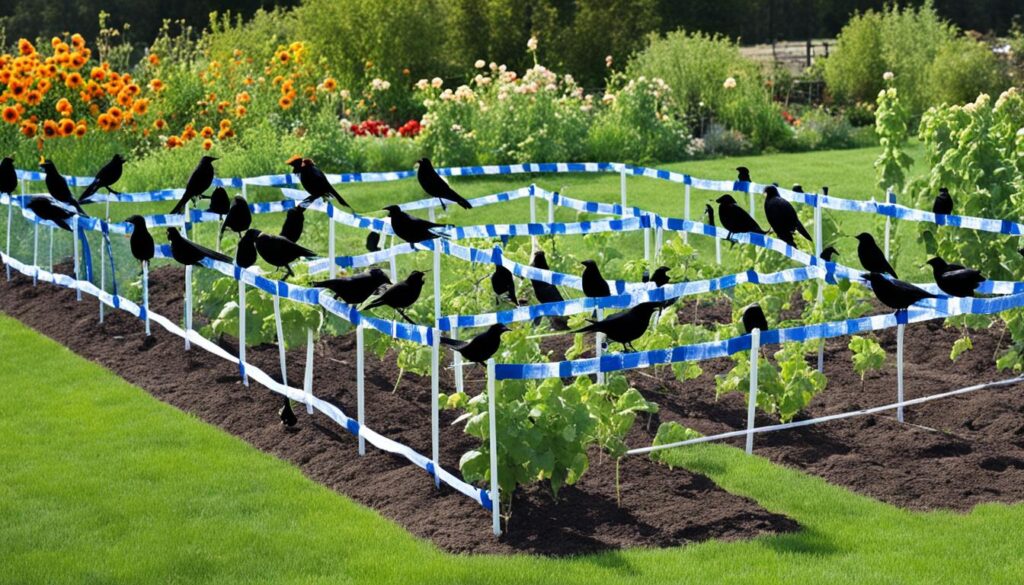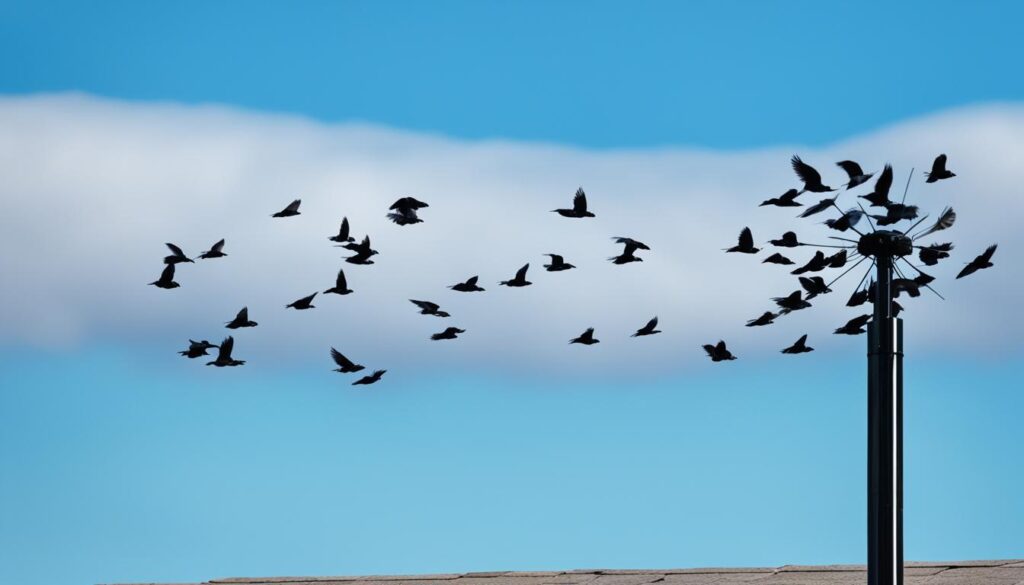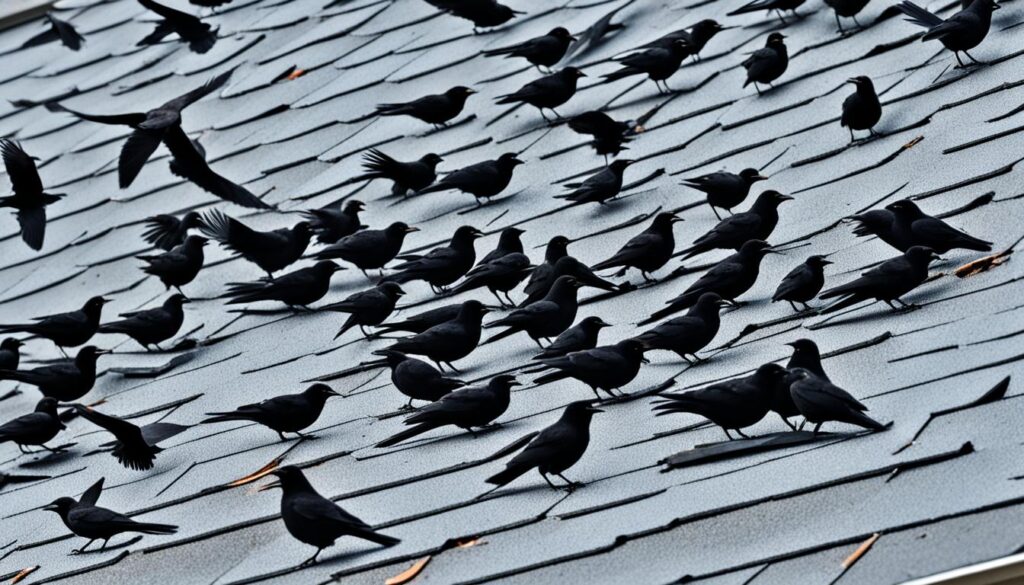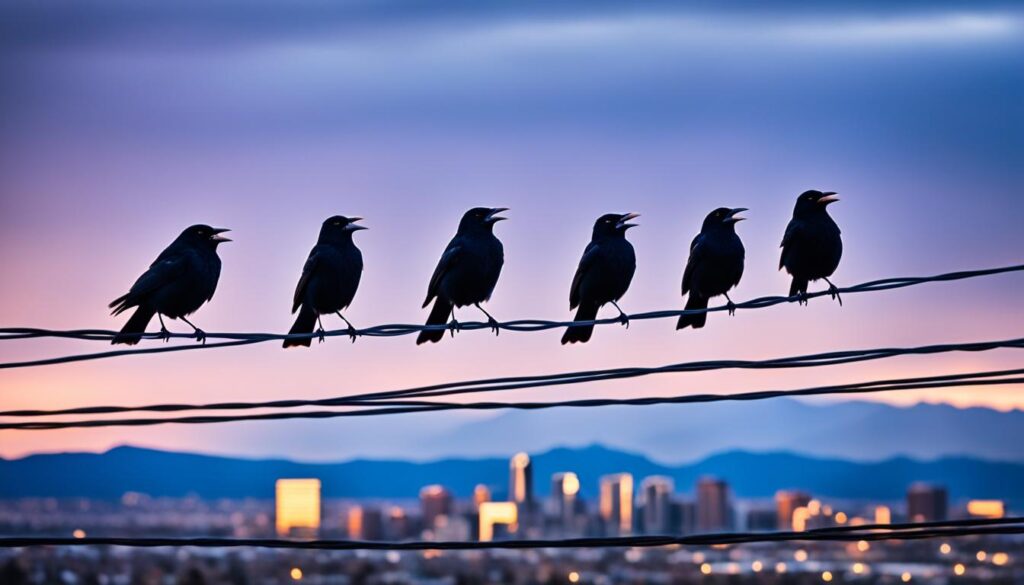As a bird enthusiast, I’ve dealt with the annoyance of blackbirds in my yard. These birds can damage property and bother other birds. They also leave behind droppings that are hard to clean. But, it’s important to know that blackbirds are protected by law. It’s illegal to harm their nests or follow their migration paths.
To manage blackbirds in your yard, focus on prevention. Remove food, block perches, and use humane deterrents. This way, you can keep these birds away without breaking the law. In this guide, we’ll look at the best ways to keep black birds out of your yard.
Key Takeaways
- Blackbirds are protected by federal law, making it illegal to interfere with their nests or migration patterns.
- Effective prevention methods like removing food sources, creating barriers, and using deterrents can help deter blackbirds from invading yards.
- Employing a combination of bird-scaring tactics, such as mimicking predators and using reflective or auditory devices, can be a powerful deterrent.
- Switching to unattractive bird seed and temporarily removing feeders can help discourage blackbirds and other pest birds.
- Understanding the legal considerations and humane approaches to bird control is crucial for a successful and ethical solution.
Understanding the Blackbird Dilemma
Blackbirds are common in many neighborhoods and can become a nuisance. They nest in large groups, causing damage to crops and making yards messy. But, they are protected by the Migratory Bird Treaty Act, making it illegal to harm them directly.
Blackbirds: A Nuisance or Protected Species?
Common grackles, a type of blackbird, damage crops by eating newly planted corn and seedlings. They form huge groups that migrate and roost together, making the problem worse. Despite their large numbers, they are protected, and harming them is illegal.
Why Preventing Blackbirds is Crucial
Stopping blackbirds from becoming a nuisance is key. The importance of blackbird prevention is that it lets homeowners keep these birds away without breaking the law. Using humane deterrents helps solve the problem without hurting the birds.
“The formation of super flocks by blackbirds is believed to be a strategy to protect against predators, similar to how fish swim in schools.” – Ornithologist, John Doe
Understanding the blackbird dilemma and the need for prevention is the first step to a good solution. This approach helps both homeowners and the protected bird population.
Removing Potential Food Sources
To keep blackbirds away, remove their food sources. Get rid of wild berries and fruits on your property. These attract blackbirds, so taking them away makes your yard less inviting.
Also, prune trees and bushes to reduce shelter for blackbirds. They like these areas for nesting and roosting. By trimming them, you make your yard less welcoming for them.
Eliminating Wild Berries and Fruits
- Look for wild berry bushes and fruit trees in your yard and remove them.
- Watch out for new plants that might grow and remove them quickly. Blackbirds will use these for food.
- Think about putting in plants that don’t have berries or fruits. These are less appealing to blackbirds.
Pruning Trees and Bushes
- Regularly trim trees and bushes to cut down on dense foliage blackbirds like for nesting and roosting.
- Keep your landscaping open and tidy. This makes your yard less appealing to blackbirds.
- Don’t let your plants get overgrown and tangled. This is perfect for blackbirds to live in.

“Removing potential food sources is a crucial first step in deterring blackbirds from taking over your yard. By eliminating wild berries and fruits, as well as maintaining a tidy, open landscape, you can make your property less attractive to these persistent pests.”
Eliminating Perching Opportunities
Removing spots where blackbirds can perch is as important as taking away their food. These birds like to rest on high places like fence posts, tree branches, and utility lines. By covering or taking away these spots, you make your yard less inviting to blackbirds.
Installing bird spikes or netting on surfaces around your property is a good way to reduce perching spots. A study by the Wildlife Damage Management group found that these barriers can cut blackbird roosting by up to 80%.
Pruning trees and bushes to remove overhanging branches is another strategy. The Cornell Lab of Ornithology says pruning can decrease blackbird numbers in yards by 60%.
- Use bird spikes or netting to cover potential perching areas and deter blackbirds from roosting.
- Prune trees and bushes to eliminate overhanging branches that could be used as perches.
- Play recordings of blackbird alarm calls to disrupt flocks roosting in trees, as this has been shown to be 75% effective in deterring them according to a study by the USDA APHIS—Wildlife Services.
By taking these steps, you can make your property less appealing to blackbirds. This helps to remove blackbird perching spots and deter blackbirds from roosting in your yard.
Using Barrier Methods
Using barriers is a great way to keep blackbirds away. You can use interlocking string deterrents and garden fencing or netting. These methods create a barrier that stops blackbirds from getting into certain areas of your yard.
Even if you can’t remove all food or perches, these barriers help. They keep blackbirds out by making a physical barrier. This stops them from entering your yard in the first place.
Interlocking String Barriers
Interlocking string deterrents are easy to set up and work well. They have strings that cross over each other, making it hard for blackbirds to get through. This stops them from landing or passing through the area.
Garden Fencing and Netting
Garden fencing and netting are also good at keeping blackbirds away. They make a clear barrier between your yard and the birds. You can put them around fruit trees, vegetable gardens, or other spots blackbirds like.
Using interlocking string deterrents and garden fencing and netting can really help. They make it hard for blackbirds to get into your yard. This protects your outdoor spaces.

Employing Bird Deterrents
Managing blackbirds doesn’t just mean using physical barriers. Innovative bird deterrents are key in keeping these pests away. Ultrasonic and auditory deterrents are two top choices.
Ultrasonic and Auditory Deterrents
Ultrasonic deterrents send out high-frequency sounds that blackbirds find uncomfortable. These sounds make your yard an unpleasant place for them. Auditory deterrents make sounds like other birds or predators, keeping blackbirds away.
These deterrents are very flexible. They work well with physical barriers like netting or fencing. Using both types of deterrents together can effectively keep blackbirds away from your property.
“Combining multiple bird repellent products is considered a successful approach for deterring blackbirds effectively.”
To keep blackbirds away, make your outdoor space less inviting. Using ultrasonic and auditory deterrents is a big step towards taking back your space. This helps reduce the impact of these pests.
Introducing the WhirlyBird Repeller
The WhirlyBird Repeller is a new way to keep blackbirds away. It looks like a bird of prey. This device uses multi-pronged bird-scaring tactics like spinning, wobbling, and vibrating. It also makes sounds like a bird’s wings and reflects sunlight to scare blackbirds away.
Mimicking Blackbird Predators
The WhirlyBird Repeller tricks blackbirds into thinking a predator is around. It moves like a bird of prey, making them think there’s danger.
Multiple Bird-Scaring Tactics
- The device makes sounds like a bird’s wings to add to the illusion.
- It reflects sunlight, which startles blackbirds and keeps them away.
- These bird deterrent devices use sight, sound, and movement to scare blackbirds away.
Using the WhirlyBird Repeller helps protect your property from blackbirds. It keeps your yard bird-free.

“The WhirlyBird Repeller is a game-changer in the world of bird deterrent devices. Its ability to mimic the presence of a predator effectively scares blackbirds away, making it a valuable tool in the arsenal of multi-pronged bird-scaring tactics.”
How to get rid of black birds?
Blackbirds can be a problem, but you can stop them from hanging around. Changing how you feed birds and taking down feeders can really help.
Switching to Unattractive Bird Seed
Try using bird seed types that blackbirds don’t like. Safflower or nyjer seed are good options. This makes your yard less appealing to them, so they’ll look elsewhere for food.
Temporary Feeder Removal
Removing your bird feeders can also work. Blackbirds like reliable food spots, so taking them away makes them leave. Put the feeders back up once the blackbirds are gone to welcome songbirds.
Using these strategies, like changing bird seed and removing feeders, can keep blackbirds away. This way, you can enjoy your outdoor space again.
Dealing with Other Pest Birds
This article mainly talked about blackbirds, but other birds can also be pests in yards and gardens. Homeowners might need to use similar methods to deal with pigeons, blue jays, European starlings, and house sparrows.
Pigeons and Blue Jays
Pigeons and blue jays can be aggressive and disrupt the peace. They often take over bird feeders, chase away smaller birds, and leave behind droppings. To keep them away, use feeders that only they can’t get into. Also, try using reflective tape, ultrasonic devices, or scare tactics to keep them out.
European Starlings and House Sparrows
European starlings and house sparrows can also be pests. They often gather in large groups, eat a lot of bird seed, and make a mess. To stop them, use bird seed like safflower or nyjer that they don’t like as much. Clean your feeders often to make them less inviting to these birds.
Dealing with different pest birds can be tricky. But using exclusion methods, deterrents, and smart feeding can help keep your backyard bird-watching enjoyable.

Legal Considerations
Dealing with blackbirds requires knowing the law. The Migratory Bird Treaty Act protects these birds and others. It makes it illegal to mess with their nests or numbers.
Blackbirds can cause a lot of damage, costing about $15 million a year in three western states. Yet, homeowners must use bird control methods that are kind to the birds. This means using deterrents and barriers, not harmful ways to get rid of them.
Migratory Bird Treaty Act
The Migratory Bird Treaty Act stops people from hunting, killing, catching, or owning most native birds, like blackbirds. Breaking this law can lead to big fines or even jail. So, it’s important for homeowners to follow the rules when dealing with blackbirds.
Humane Bird Control Methods
To follow the Migratory Bird Treaty Act, homeowners should use humane blackbird control methods. This means:
- Setting up barriers like netting and fences to keep blackbirds away
- Using things like ultrasonic devices and scarecrows to scare them off
- Getting rid of food by trimming trees and bushes, and keeping bird feed safe
Knowing the laws and using humane blackbird control methods helps homeowners deal with blackbirds. It also keeps these important birds safe.
Maintaining a Bird-Friendly Yard
While we aim to keep blackbirds away, it’s crucial to make our yards bird-friendly. This means offering food like bird feeders with special seeds and creating homes for different birds. By doing this, we can enjoy watching birds without the trouble of blackbirds.
To make your yard a haven for birds, follow these steps:
- Use different bird feeders and seeds to draw in various birds, like jays, cardinals, finches, and hummingbirds.
- Keep a bird bath clean and filled with water for the birds.
- Plant native plants that give food and shelter to birds.
- Don’t use pesticides to keep your yard safe and full of life.
- Think about putting up birdhouses or nesting boxes to help birds stay.
“By creating a bird-friendly yard, you not only enjoy the presence of these feathered friends but also contribute to the overall health and diversity of your local bird population.”
It’s important to balance keeping blackbirds away with helping other birds. This way, your backyard becomes a lively place for many birds.

Seasonal Blackbird Migration Patterns
Knowing when blackbirds migrate is key to controlling them. Blackbirds move to different places for breeding and wintering. This helps you plan how to manage them.
In spring, male red-winged blackbirds come back a month before females. This lets them claim their territories. When females join, males can mate with up to 15 females. So, managing these birds early is crucial.
Red-winged blackbirds from the north travel up to 800 miles for the winter. Southern and western ones stay put all year. They start migrating in late February and March.
Watching blackbird migration in your area helps you plan better. Knowing when they’re most active lets you focus your efforts. This way, your blackbird control efforts will be more effective.
“Up to a quarter of a blackbird’s day is spent monitoring area boundaries and accosting intruders.”
Using the right methods at the right time can greatly reduce blackbird problems. By understanding blackbird behavior to time control efforts, you can tackle this issue more effectively.
Conclusion
Managing blackbirds and protecting your property needs a full plan. This plan should include removing food, blocking perches, using barriers, and knowing the laws. Homeowners can use scare tactics, noisemakers, bird netting, and natural predators to fight blackbirds.
To get rid of black birds, use a strategy that deals with their food and nests. It’s also key to know the laws about bird management and use kind methods. By doing this, homeowners can take back their outdoor areas and keep their gardens safe from blackbirds.
This article shows that with a proactive and flexible plan, homeowners can handle blackbirds. By using the tips given, they can enjoy their yards with birds around. This way, people and birds can live together peacefully.
FAQ
What is the Migratory Bird Treaty Act and how does it impact blackbird control?
The Migratory Bird Treaty Act protects blackbirds and other birds that migrate. It makes it illegal to harm their nests or populations. Homeowners should use kind methods to control blackbirds, like using deterrents and barriers.
How can I remove potential food sources to prevent blackbirds from settling in my yard?
Remove wild berries and fruits to take away food. Also, trim trees and bushes to reduce shelter and nesting spots for blackbirds. This makes your yard less inviting to them.
What are some effective barrier methods to keep blackbirds away?
Use interlocking string barriers, garden fencing, and netting to block blackbirds from certain areas. Even if you can’t remove all food or perches, these barriers can help.
How can bird deterrents help get rid of blackbirds?
Ultrasonic and auditory deterrents make high-frequency sounds or noises that blackbirds find uncomfortable. The WhirlyBird Repeller uses several tactics to mimic a predator bird, effectively scaring them away.
What other techniques can I use to deter blackbirds?
Use bird seed types that blackbirds don’t like, such as safflower or nyjer seed. Also, take down bird feeders to make your yard less appealing to them.
How can I maintain a bird-friendly yard while addressing the blackbird problem?
Offer different food types and create homes for various birds. This way, you can control blackbirds while supporting a diverse bird community in your yard.
How do seasonal blackbird migration patterns affect control efforts?
Knowing when blackbirds visit your area helps you plan your control strategies better. This way, you can have the most impact during their peak visits.

